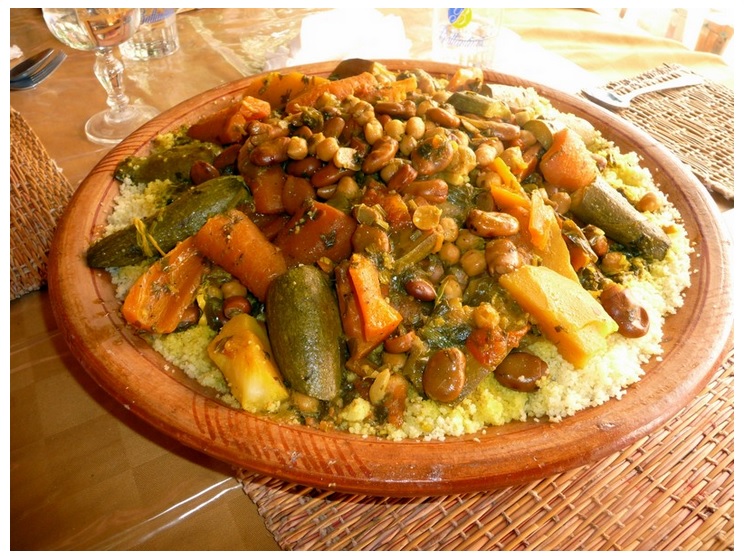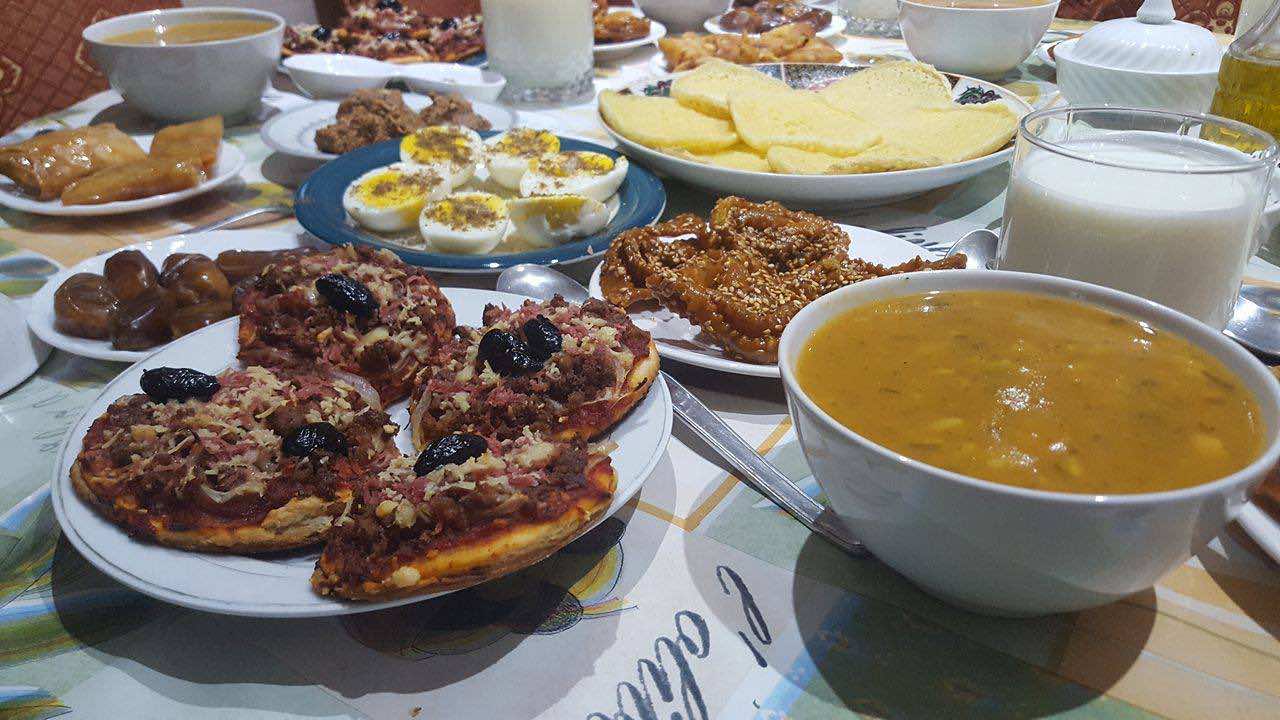
Taroudant - The cultural diversity in morocco (Amazighs, Arabs, Hassanis, Jews, and Andalousians) contribute to the richness of its remarkable cuisine that is among the top best cuisines of the world.
Known for its mouthwatering spicy dishes and amazingly sweet pastry and bread, it is no wonder that the kingdom appears on the world best travel destinations for food lovers.
The famous dishes in the Moroccan cuisine:
[caption id="attachment_154009" align="aligncenter" width="744"] Couscous[/caption]
Couscous[/caption]
Couscous
Couscous is a purely Moroccan dish. Traditionally, it was the regular dinner for nearly all Moroccans, but as time went by people started to usually prepare it every Friday. Like any pasta, it is prepared with flour rolled in a skilful manner to form fine grains then steamed for a while and dried. When it is dried they store it in bags. Fortunately, ready to use couscous can be found in every market.
[caption id="attachment_154011" align="aligncenter" width="500"] Tagine[/caption]
Tagine[/caption]
Tagine
Tagine is named after the special earthenware pot in which it is cooked. Yet, for all Moroccans it connotes an irresistible delicious taste and a pleasingly sweet smell. It is cooked and braised slowly at low temperatures, resulting in tender meat with aromatic vegetables and sauce, and it is served hot.
It has different distinctive sweet tastes depending on the ingredients, but the process remains the same.
[caption id="attachment_154010" align="aligncenter" width="704"] Bstilla[/caption]
Bstilla[/caption]
Bstilla
Bstilla is undoubtedly one of the ultimate manifestations of beauty, refinement and delicacy of Moroccan cuisine. It is prepared for great dinners and wedding ceremonies. Usually, it is served after small plates of fresh salads and before the Tagine with meat.
[caption id="attachment_154007" align="aligncenter" width="650"] Tangia[/caption]
Tangia[/caption]
Tangia
Tangia (sometimes spelled tanjia) is a Moroccan urn-shaped clay pot primarily used for preserving butter, honey, olive oil, and occasionally for cooking. The word Tangia is now famous for the rich and delicious meat-based dish prepared in Morocco, more specifically in Marrakesh.
A Tangia, like Tagines and other clay cookware, should be soaked in water for at least one day before its first use to guarantee a long life service. It is also advisable to cook some oil or fat in the new earthen cookware to make it strong and last for a long time serving you with irresistible taste.
It is believed that Tangia originated in Marrakesh. The most famous story relates the invention of Tangia to unmarried working men. The bachelor workers would make equal contributions to buy meat and the entire necessary ingredients, and would appoint one of their colleagues to prepare it and take it to a public oven before heading to their place of work. There, the Tangia would be placed into the deep hot ashes to be slowly cooked until the workers came back to retrieve it when their work is done.
Like tea, Tangia remains men’s dish par excellence. Even though it is usually made by men, Tangia can be prepared by everyone provided that they master the secret of a good one, which is revealed in this traditional recipe.
[caption id="attachment_154012" align="aligncenter" width="403"] Zaaluk[/caption]
Zaaluk[/caption]
Zaaluk
Zaaluk is a spicy authentic Moroccan salad based on mashed eggplants and tomatoes flavored with many spices. Moroccan families usually serve it as appetizers that go with principle meals namely Tagine or Marqa (boiled vegetables with meat and sauce). It can be prepared in just few minutes and may be served alone with some bread for quick snacks. Since it is spicy, it helps stimulating the appetite. In the Middle East, they have a somehow similar salad called Baba Ghanouj. People usually eat it cold, but you may also enjoy its irresistible spicy taste while it is still hot.
[caption id="attachment_154023" align="aligncenter" width="599"] Steamed and stuffed chicken[/caption]
Steamed and stuffed chicken[/caption]
Steamed and stuffed chicken
It is considered among the prestigious dishes that Moroccans serve for their special guests. In special ceremonies and festivities, people prepare it as a basic meal along with spicy thick sauce and pickled lemon. Nowadays, people prepare it more often as a regular dish for lunch. With bread, cooked vegetables and some salad, it can be unbelievably a delicious and a rich meal.
[caption id="attachment_154015" align="aligncenter" width="635"] Lmrozia[/caption]
Lmrozia[/caption]
Lmrozia
“Lmrozia” is an authentic Moroccan dish usually prepared in “Eid Al Adha”, a religious feast. The name “Lmrozia” derives its meaning from the secrete mixture of more than 40 spices and herbs. In the beginning, “lmrozia” was a method of preserving meat of “Eid Al Adha” at the absence of refrigerators in early times, without having the intention to invent a new distinctive and special dish.
Even though refrigerators are now abundantly available, Moroccans still prepare this spices based dish just the same way. The popularity of lmrozia is due to its distinctive delicious taste combining somehow different sweet and spicy tastes. Some Moroccan families keep “lmrozia” prepared with meat of “Eid Al Adha” in a refrigerator for months to be served for their relatives and special friends who are living abroad when they come during holidays.
[caption id="attachment_154006" align="aligncenter" width="736"] Rfissa[/caption]
Rfissa[/caption]
Rfissa
Rfissa is an authentic traditional Moroccan dish. It is famous among Moroccans even though it may not be regarded a regular daily dish. Exchanging visits among Moroccan women is very common and “Rfissa” is considered a special dish to be served in such occasions. Traditionally, it is prepared for a woman after delivery for its rich nutrient facts, and as an act of gratitude and rewarding on the part of the family.
It is considered a women’s dish par excellence, but men also love it.
[caption id="attachment_154019" align="aligncenter" width="547"] Steamed sheep’s head[/caption]
Steamed sheep’s head[/caption]
Steamed sheep’s head
For foreigners some food may seem very strange and more exotic fare like sheep’s testicle, escargots, steamed sheep’s head and spicy fried cow or sheep’s brain, but the taste is irresistibly delicious. The head of a lamb steamed in a cook pressure over a low heat fire after being charred and cleaned is very delicious. It may sound a weird idea but once you try it especially with some more spicy sauce you simply discover the delicious taste of those sticky meat of the head of a lamb.
[caption id="attachment_154016" align="aligncenter" width="684"] Kouraine[/caption]
Kouraine[/caption]
Kouraine
In Morocco, the lamb is fully exploited and probably nothing is wasted because Moroccan cuisine is very rich and nearly all the parts of the lamb are used for a sweet and unique dish. kouraine is a Moroccan dish par excellence which is prepared with the legs of cow, lamb or goat and chickpeas.
Some people prefer to add raisins to the recipe to give it a distinguished sweet flavor. Kouraine is prepared often, but during the days of Eid Al Adha, Moroccan families have to prepare it with the legs of their slaughtered lamb as a very special meal.
[caption id="attachment_154021" align="aligncenter" width="709"] Harira[/caption]
Harira[/caption]
Harira
Moroccan soup or Harira used to be among the regular and necessary food served in breakfast for most of Moroccans. In the southeast regions of Morocco, it is usually served with dates and in some Moroccan cities, it is served with Chebakia, very sweet and honeyed cookies. Nowadays, Moroccan families prepare Harira occasionally, and more often for dinner. However, during the holy month of Ramadan, Harira is an indispensable meal along with other delicious food to be served for breaking the fast. Harira is the typical meal that gives Ramadan a Moroccan touch and identity.
The post In Pictures: Most Famous Authentic Moroccan Dishes appeared first on Morocco World News.




















































